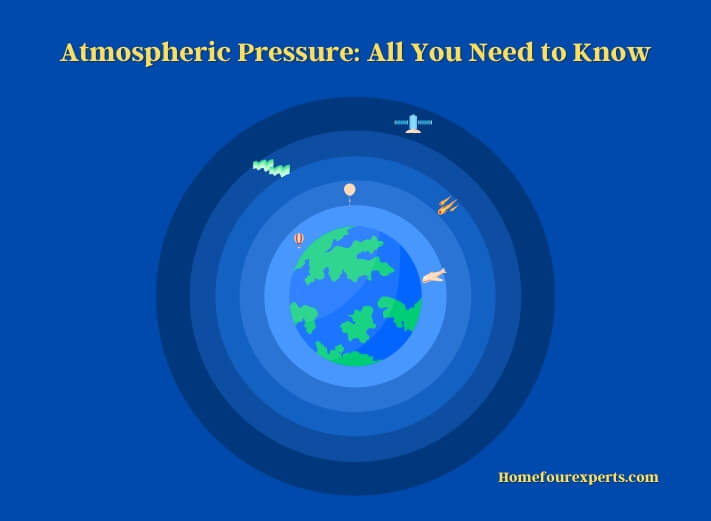Atmospheric pressure, a topic that might not frequently cross our minds, has a significant impact on our daily lives. From determining the weather to affecting our health, understanding the basics of atmospheric pressure is essential. In this article, we will explore the factors affecting atmospheric pressure, its measurement, and its effects on both the environment and our daily lives.

What is Atmospheric Pressure?
Atmospheric pressure, also known as air pressure or barometric pressure, is the force exerted by the weight of the Earth’s atmosphere on a given surface. It is measured in units called millibars (mb) or hectopascals (hPa). The standard atmospheric pressure at sea level is 1,013.25 hPa or 1 atmosphere (atm).
Factors Affecting Atmospheric Pressure
Temperature
Temperature plays a crucial role in determining atmospheric pressure. Warmer air rises, causing a decrease in pressure, while cooler air sinks, increasing the pressure. This phenomenon leads to the formation of high and low-pressure systems that influence weather patterns.
Altitude
As we go higher in altitude, the atmospheric pressure decreases. This is because there are fewer air molecules at higher altitudes, resulting in lower pressure.
Humidity
Humidity, or the amount of water vapor in the air, can also affect atmospheric pressure. Moist air is lighter than dry air, so areas with higher humidity generally have lower air pressure.
How Atmospheric Pressure is Measured
Barometer
A barometer is an instrument used to measure atmospheric pressure. It detects changes in air pressure and helps predict short-term weather changes.
Types of Barometers
Mercury Barometer: The oldest and most traditional type, it uses a column of mercury to measure air pressure.
Aneroid Barometer: A more modern and portable version, it uses a sealed chamber that expands or contracts with changes in pressure.
Digital Barometer: The latest technology, it uses electronic sensors to measure pressure and can provide accurate readings and forecasts.
Applications of Barometers
Barometers play a vital role in meteorology, aviation, and other industries where precise atmospheric pressure readings are necessary.
Effects of Atmospheric Pressure
On Human Health
Atmospheric pressure can have both direct and indirect effects on human health. High altitude can cause altitude sickness, while rapid changes in pressure can lead to sinus pain and headaches.
Altitude Sickness
Altitude sickness occurs when the body struggles to adapt to lower air pressure and oxygen levels at high altitudes. Symptoms may include headaches, nausea, dizziness, and shortness of breath.
Weather and Climate
Atmospheric pressure is a significant factor in determining weather and climate. High-pressure systems typically bring clear skies and calm weather, while low-pressure systems often result in clouds, precipitation, and storms.
Atmospheric Pressure in Daily Life
Aviation
Pilots must constantly monitor and adjust to changes in atmospheric pressure. Accurate pressure readings are critical for determining altitude, ensuring safe takeoffs and landings, and maintaining proper cabin pressure during flights.
Scuba Diving
Scuba divers must be aware of the increased pressure underwater, which can cause decompression sickness if not managed correctly. Divers must ascend slowly and use decompression stops to allow their bodies to adjust safely to the changing pressure.
Weather Forecasting
Atmospheric pressure measurements are a crucial part of weather forecasting. Meteorologists use pressure readings to predict the movement of weather systems and the likelihood of various weather events.
Interesting Facts about Atmospheric Pressure
Highest and Lowest Recorded Pressure
The highest atmospheric pressure ever recorded was 1,085.7 hPa in Tosontsengel, Mongolia, in December 2001. Conversely, the lowest pressure recorded was 870 hPa during Typhoon Tip in October 1979.
Rapid Changes in Atmospheric Pressure
Rapid changes in atmospheric pressure can lead to powerful storms and extreme weather events. Hurricanes and tornadoes are examples of weather phenomena driven by intense low-pressure systems.
Conclusion
Atmospheric pressure is an essential aspect of our lives, influencing the weather, our health, and various industries. Understanding the factors that affect atmospheric pressure and how it is measured can help us appreciate its impact on our daily lives and the environment.
FAQs
What is the standard atmospheric pressure at sea level?
The standard atmospheric pressure at sea level is 1,013.25 hPa or 1 atmosphere (atm).
How does temperature affect atmospheric pressure?
Warmer air rises, causing a decrease in pressure, while cooler air sinks, increasing the pressure.
Why does atmospheric pressure decrease with altitude?
Atmospheric pressure decreases with altitude because there are fewer air molecules at higher altitudes, resulting in lower pressure.
What are some common effects of atmospheric pressure on human health?
High altitude can cause altitude sickness, while rapid changes in pressure can lead to sinus pain and headaches.
How is atmospheric pressure used in weather forecasting?
Meteorologists use atmospheric pressure measurements to predict the movement of weather systems and the likelihood of various weather events.
About This Writer

Hi, I am responsible for the 'Homeowners Power Solutions' category. My name is Liam Jaxon and a licensed technician with 7 years of experience in vehicle batteries, electrical gadgets, and home appliances. My working experience in different residential & light commercial electrical sectors and the automobile industry helped to acquire vast knowledge in this industry.